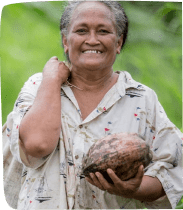A milestone report released today by Oxfam Aotearoa reveals that some popular New Zealand clothing brands are failing to provide basic information on where their clothes are made, despite this being increasingly standard in Australia and in Europe.
Part of the ‘What She Makes’ campaign, the report reveals supply chain transparency ratings for six of New Zealand’s top fashion brands based on public data available to consumers. While some brands performed extremely well, receiving a full five-star rating, popular brands Glassons and Hallenstein Bros received a disappointing two-star rating.
“Well-known fashion brands have really stepped up for this milestone,” said Shalomi Daniel, Oxfam Aotearoa’s Campaign Lead for Gender and Economic Justice.
“We’re thrilled to see New Zealand founded brands and household names Kathmandu and Macpac performing equally as well as large multinational brands H&M and Lululemon all of whom received a full five-star rating. All four brands’ transparency extends to full lists of their Tier 1 factories, where they are located, and data about the people who are working in them.
“It is disappointing that Glassons and Hallenstein Bros have chosen not to share the most updated transparency information with their customers. Through not meeting all our basic criteria, unfortunately they received only a two-star rating. We hope to see them improve this as soon as possible.
“More and more, customers are expecting their favourite brands to be upfront about where their clothes are made. Transparency is the foundation of an ethical supply chain – it allows workers, unions, and groups of people like us to scrutinise the working conditions of these factories and ensure that women who make our clothes are treated and paid fairly.
“If a brand doesn’t share this data, that doesn’t mean the working conditions in their factories are bad – but it does make it that much harder for anyone to find out.
“In some cases, brands themselves don’t even know where their garments are being made. After the Rana Plaza disaster in 2013, some top international fashion brands only learned their workers had been killed when their logos were found in the rubble.
“We’re calling for improved transparency across the fashion industry. It’s clear the basic standards have shifted – and they’ll only continue to. While we focused on Tier 1 suppliers in this report – the factories that directly supply the brands – some of the brands we looked at are already looking into reporting on their Tier 2 suppliers, the ones that supply their Tier 1 factories. This is commendable, and we see this sort of transparency being the future for the industry.”
This transparency milestone is the second in the What She Makes campaign, where Oxfam Aotearoa is working alongside brands on a journey to paying the women who make their clothes in countries like Bangladesh and China a living wage.
In late 2022, the first campaign milestone asked the brands to make a public commitment to paying workers in the supply chain a living wage. The campaign’s next milestone will be next year, when brands will be asked to separate labour costs in price setting and negotiation.
“The good news is this is not the end – we will continue this journey with the brands to ensure that they pay the women who make our clothes a living wage. We welcome anyone wanting to support the campaign to help us demand better for the women who make our clothes by pledging their commitment at oxfam.org.nz/what-she-makes.”
Full list of brand ratings from the What She Makes Brand Transparency Report:
- Hallenstein Bros – 2 stars
- Glassons – 2 stars
- Kathmandu – 5 stars
- Macpac – 5 stars
- H&M – 5 stars
- Lululemon – 5 stars
Notes:
The What She Makes campaign calls on clothing brands sold in Aotearoa New Zealand to pay a living wage to the women who make our clothes. Through the What She Makes campaign, Oxfam Aotearoa works directly with the brands to help them achieve each milestone. The ratings help keep brands on track as they go.
About the brand tracker – The brand tracker uses a star-rating system which provides a snapshot of how well each brand is doing in each milestone. The tracker includes five milestones which companies will be evaluated against:
1. Make a commitment (released November 2022)
As a first step, we want brands to make a credible, public commitment to pay a living wage to garment workers in their supply chain. This is a powerful demonstration that the brand is embarking upon their living wage journey.
2. Be transparent (May 2023)
Brands should be transparent and disclose their full supply chain and publish the following information on their website: factory names and addresses, parent companies, number of workers and breakdown by gender, sourcing channel, and date when the list is published or updated along with a statement that it is a complete list of the brand’s tier-one suppliers.
3. Separate labour costs (May 2024)
Separation of labour costs during price negotiations helps to quickly identify if the wages being paid to garment workers correspond to a living wage or not. It also allows the clothing brands and factories to negotiate a price without affecting the wages.
4. Publish a plan (November 2024)
Brands should develop and publish a step-by-step strategy outlining how and when a brand will achieve its commitment to pay workers a living wage and meet all requirements with clear milestones and targets.
5. Pay a living wage (TBC)
Within 4-6 years of making a commitment, brands should be paying a living wage within their supply chains. This requires collaboration, consultation, and public reports on their progress throughout the process.





